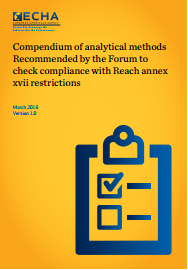Compendium on analytical methods

Compendium on analytical methods to enforce restrictions
Compendium of analytical methods Recommended by the Forum to check compliance with REACH Annex XVII restrictions
The compendium describes over 10...
ID 16906 | 22.06.2022 / In allegato linee guida JRC 2022
Natech risk management - Guidance for operators of hazardous industrial sites and for national authorities
Natural hazards, such as earthquakes, floods or storms, can trigger the release of toxic substances, fires and explosions when impacting industrial installations that process, store or transport hazardous materials.
This type of event is called Natech (natural hazard triggered technological) accident.
Impacts on industrial operations and hazardous infrastructure are a recurring but often overlooked feature in many natural disaster situations. With climate change affecting the intensity and frequency of some natural events, Natech risk has become a topic of concern for disaster risk management at local, national and international levels.
Following a number of important accidents, awareness of Natech risk has increased in the European Union, and the risk has been acknowledged in legal acts on chemical accident prevention. In 2012, an amendment of the EU Seveso Directive on the control of major accident hazards involving dangerous substances explicitly introduced Natech risk as an issue of concern that is required to be addressed.
To date the implementation of effective Natech risk management has been hampered by a general lack of guidance on how to conduct Natech risk assessment.
In order to facilitate compliance with the requirements of the Seveso III Directive or similar legislation, this document aims to provide technical guidance on Natech risk management for operators of hazardous installations and national authorities. It outlines the necessary steps in the Natech risk management process and discusses the main challenges that hamper its proper implementation.
While emphasising the identification and modeling of specific scenarios for Natech risk assessment, the document also provides solutions for addressing existing gaps in Natech risk assessment and the control of Natech risk.
Although this guidance focuses on Seveso requirements, the Natech risk management principles discussed herein can also be adopted in other industry sectors that handle hazardous materials.
________
Contents
Acknowledgements
Abstract
1 Introduction
2 Characteristics of Natech events and associated challenges
3 Introduction to Natech risk management
3.1 Communication and consultation
3.2 Establishing the context
3.3 Risk assessment
3.3.1 Risk identification
3.3.2 Risk analysis
3.3.3 Risk evaluation
3.4 Risk treatment
3.5 Monitoring and review
4 Elements of Natech risk assessment
4.1 Natural hazard identification and characterization
4.2 Identification of critical equipment
4.3 Natural hazard damage to critical equipment
4.4 Accident contributing factors: safety barriers and utilities
4.5 Natech hazard identification
4.5.1 Direct effects of the natural hazard
4.5.2 Indirect causes
4.6 Natech consequence analysis
4.6.1 Loss of containment and critical events
4.6.1.1 LOC scenarios for damage states
4.6.2 Natech consequence scenario modelling
4.6.2.1 Natech chain of events
4.6.2.2 Simultaneous accidents
4.6.2.3 Environmental conditions
4.6.2.4 Exposure and vulnerability of endpoint receivers
4.7 Natech likelihood assessment
4.7.1 Release/top event likelihood
4.7.1.1 Damage likelihood
4.7.1.2 Likelihood of critical events due to direct damage
4.7.1.3 Probability of indirect Natech accidents
4.7.2 Natech-specific event trees
4.8 Natech risk evaluation
5 Measures to reduce Natech risk
5.1 Natural hazard impact mitigation
5.1.1 Physical measures
5.1.2 Procedural measures
5.1.2.1 Before the event
5.1.2.2 After the event
5.2 Equipment design and retrofitting
5.3 Safety barriers and auxiliary systems
5.4 Emergency planning and response to Natech accidents
5.5 Learning from past Natech accidents
References
List of abbreviations and definitions
List of boxes
List of figures
List of tables
...
Fonte: EU
Collegati

Compendium of analytical methods Recommended by the Forum to check compliance with REACH Annex XVII restrictions
The compendium describes over 10...
Recepimento della direttiva 2011/8/UE della Commissione del 28 gennaio 2011 che modifica la direttiva 2002/72/CE per quanto riguarda le restrizioni d'impiego del bisfenolo A ne...

Decisione di esecuzione (UE) 2019/1752 della Commissione del 25 febbraio 2019 che istituisce i questionari, nonché il formato e la frequenza delle relazioni che g...
Testata editoriale iscritta al n. 22/2024 del registro periodici della cancelleria del Tribunale di Perugia in data 19.11.2024